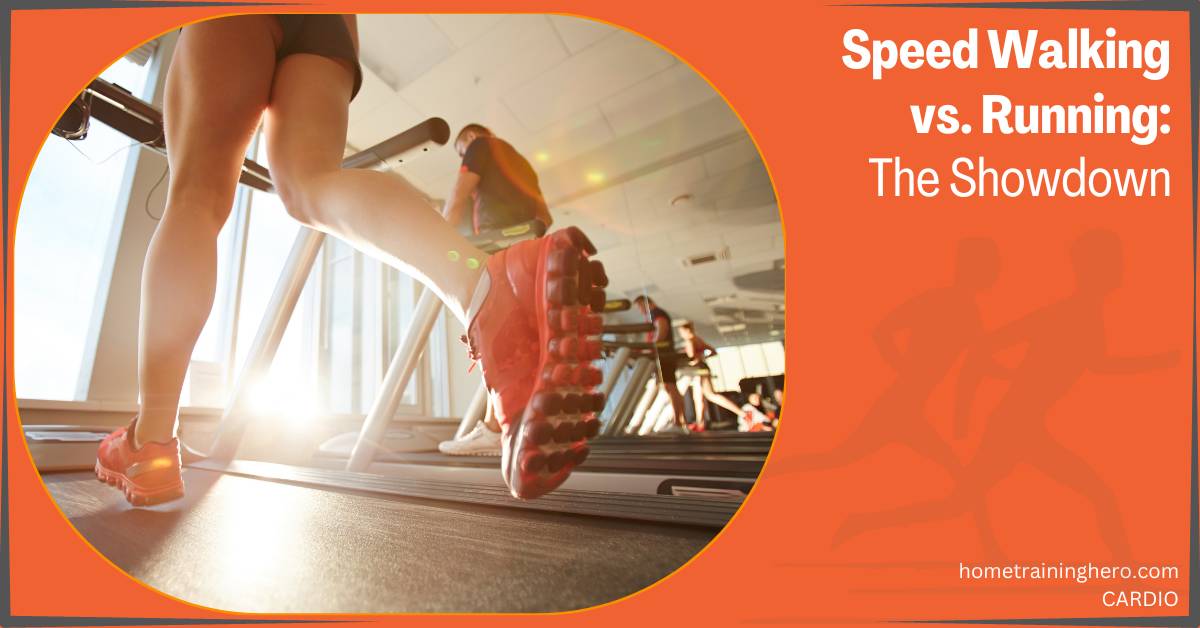When it comes to fitness and cardiovascular workouts, two activities often stand out: speed walking and running.
Both are excellent choices for staying in shape and improving your overall health – but they have distinct characteristics and benefits.
In this comprehensive guide, we will delve into the differences between speed walking and running, helping you make an informed decision about which one suits your fitness goals and lifestyle.
Contents
Introduction: The Basics of Speed Walking and Running
Speed walking and running are both aerobic exercises that get your heart rate up and provide numerous health benefits. Before we dive into the specifics, let’s take a closer look at what each activity entails.
Speed Walking
Speed walking, also known as power walking, is a low-impact exercise that involves walking briskly at a pace faster than your normal stride. It’s characterized by maintaining a continuous, fluid motion while keeping one foot on the ground at all times. Speed walking is often chosen by individuals who want to reap the rewards of cardiovascular exercise without the high-impact stress associated with running.
Running
Running, on the other hand, is a high-impact aerobic activity where both feet leave the ground during each stride. It can vary in intensity, from jogging at a moderate pace to sprinting at top speed. Running is well-known for its calorie-burning potential and its ability to enhance cardiovascular fitness.
Now that we’ve covered the basics, let’s get into the nitty-gritty details of how these two activities differ.
Speed Walking vs Running: The Key Differences
1. Impact on Joints
One of the most significant distinctions between speed walking and running is the impact on your joints. Speed walking is a low-impact exercise, making it gentler on your joints, especially the knees and hips. This makes it an ideal choice for individuals with joint issues, arthritis, or those who simply want to minimize the risk of injury.
In contrast, running is a high-impact activity that can put more stress on your joints. While it can strengthen bones and improve joint health over time, it may not be suitable for everyone, particularly those with existing joint problems.
2. Calorie Burn
If you’re aiming for weight loss, both speed walking and running can be effective, but running tends to burn more calories per minute due to its higher intensity. However, it’s essential to consider your fitness level and how long you can sustain each activity. Running may lead to quicker calorie burn, but speed walking can be sustained for longer periods, potentially resulting in comparable calorie expenditure over time.
3. Cardiovascular Benefits
Both speed walking and running provide significant cardiovascular benefits. They improve heart health, increase lung capacity, and help regulate blood pressure. However, running may offer a slight edge in terms of cardiovascular conditioning due to its higher intensity. It can lead to a more substantial increase in VO2 max, a measure of aerobic fitness.
4. Muscular Engagement
While both activities engage the lower body muscles, running activates a broader range of muscles, including the glutes, hamstrings, and calves. Speed walking primarily targets the muscles in the legs and lower back. If you’re looking to tone and strengthen your entire lower body, running might be the preferred choice.
5. Versatility and Convenience
Speed walking has the advantage of being more versatile and convenient for many individuals. It requires minimal equipment – a good pair of walking shoes – and can be done virtually anywhere. Running, on the other hand, may require more preparation, such as proper running shoes and potentially access to running trails or tracks.
Making the Choice: Which Is Right for You?
Ultimately, the decision between speed walking and running depends on your personal preferences, fitness goals, and physical condition. Here are some factors to consider when making your choice:
- Physical Condition: If you have joint issues or are new to exercise, speed walking offers a gentler starting point.
- Weight Loss: If weight loss is a primary goal, consider incorporating both activities into your routine. Speed walking can be a fantastic way to build endurance while running can help accelerate calorie burn.
- Time Commitment: Think about how much time you can dedicate to exercise. Speed walking can be easily integrated into daily routines while running may require dedicated time for longer sessions.
- Variety: Some people find that alternating between speed walking and running keeps their workouts exciting and prevents boredom.
- Injury Risk: Assess your risk of injury based on your current physical condition. If you have a history of joint problems, consult with a healthcare professional before starting a running routine.
Final Words
In the showdown between speed walking and running, there is no one-size-fits-all answer. Both activities offer unique benefits, and the choice ultimately comes down to your individual goals, preferences, and physical condition. Whether you opt for the low-impact grace of speed walking or the high-intensity rush of running, the most important thing is to stay consistent and enjoy the journey to improved health and fitness.
Remember, the best exercise is the one you’ll stick with, so lace up your shoes, hit the pavement, and start moving toward a healthier you.
Please visit my cardio archive for loads of workouts and fitness hacks!
Disclaimer: Always consult with a healthcare professional or fitness expert before beginning a new exercise regimen, especially if you have underlying health concerns or medical conditions.


